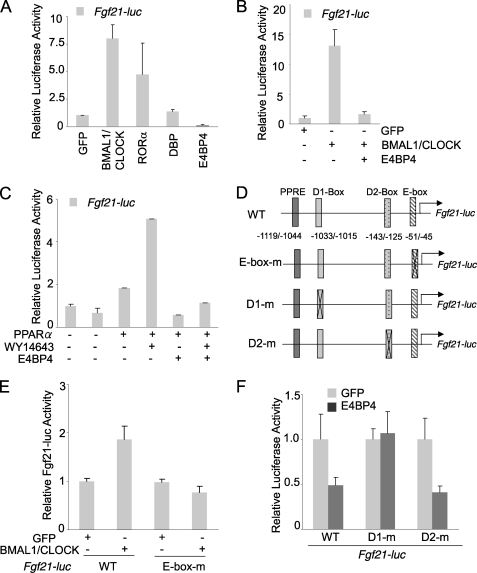FIGURE 1.
Mouse Fgf21 is a circadian output gene regulated by the circadian protein E4BP4. A, mouse Fgf21 promoter is differentially regulated by clock proteins. A luciferase vector driven by the mouse Fgf21 promoter was cotransfected with the expression vectors encoding various clock proteins in Hepa1c1c-7 cells. The relative luciferase activities were calculated based on the value of GFP group set as 1. Results are expressed as mean ± S.D. (error bars) (n = 3). B, E4BP4 overexpression blocks transcription activation of the Fgf21-luc by BMAL1-CLOCK. The mouse Fgf21 promoter-driven luciferase reporter was co-transfected with expression vectors of various clock proteins in Hepa1c1c-7 cells. The relative luciferase activities were calculated based on the value of GFP group set as 1. Results are expressed at mean ± S.D. (n = 3). C, E4BP4 abolishes the activation of the Fgf21-luc by PPARα ligand WY14643. 24 h after co-transfection with the mouse Fgf21-luc and expression vectors of E4BP4 and PPARα, Hepa1c1c-7 cells were treated with either DMSO or PPARα ligand WY14643 (10 μm) for 16 h. The relative luciferase activities are expressed as mean ± S.D. (n = 3). D, schematic diagram shows the putative binding sites (PPAR-response element (PPRE), E box, and D box) within the 1.5 kb Fgf21 promoter upstream of the transcription starting site. The E-box and D-box deletion mutants are also indicated. E, mouse Fgf21 promoter contains a functional E-box element. Deletion of the E-box binding site (−51 to −45) abolished the BMAL1-CLOCK-mediated activation of the Fgf21 promoter. F, a D-box-binding element is required for E4BP4-mediated repression of the Fgf21 promoter. The Fgf21-luc mutant D1m (−1033 to −1015 deleted) was not repressed by E4BP4 in the co-transfection assay. Both D2m mutant (−143 to −125 deleted) and wild-type Fgf21-luc respond to E4BP4 in similar manners.

